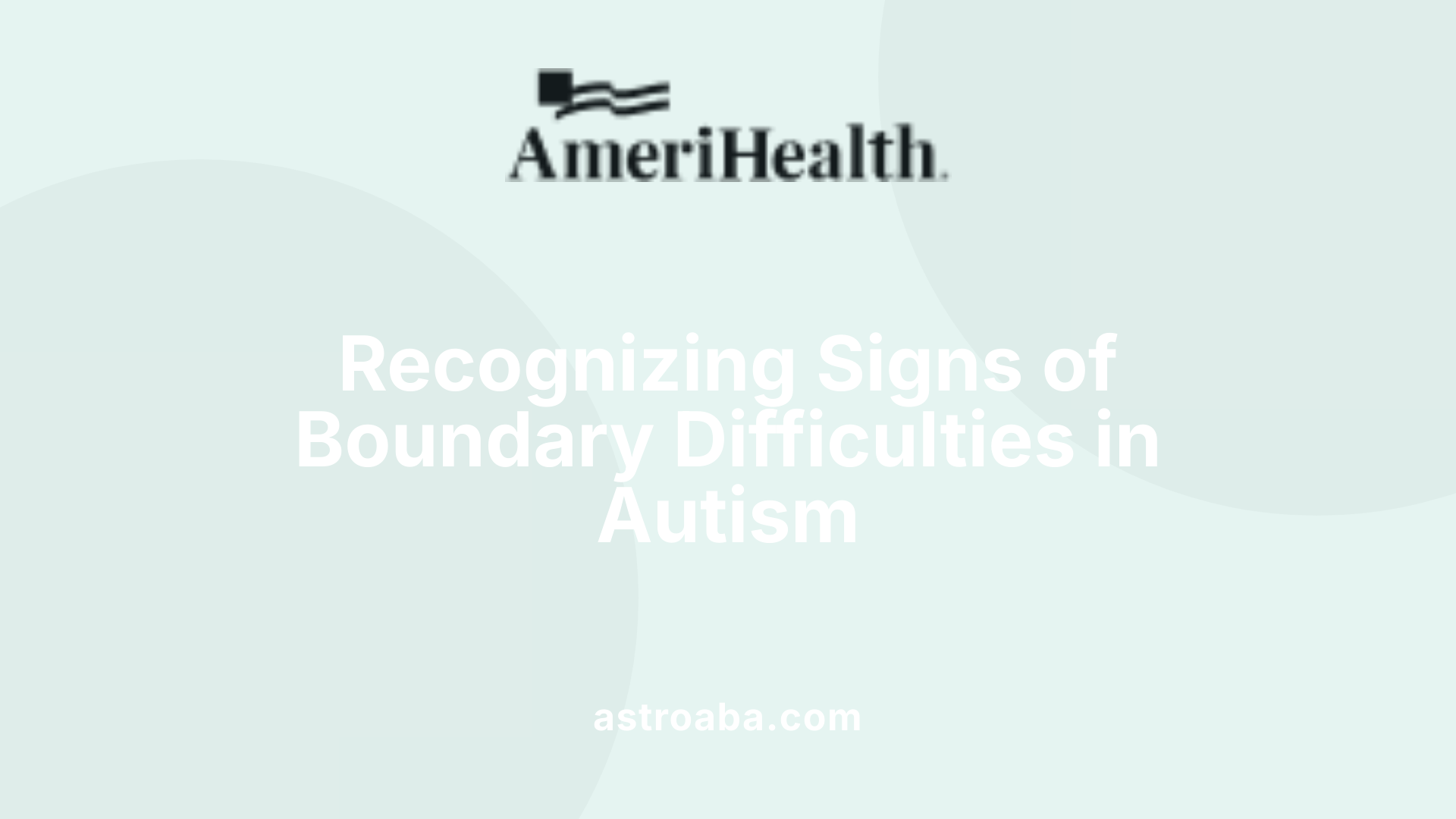How ABA Therapy Can Improve Social Boundaries Awareness
Fostering Respect and Safety: The Role of ABA in Social Boundary Awareness

Unlocking Social Success Through ABA Therapy
For individuals with autism, understanding and respecting social boundaries is crucial for building meaningful relationships and ensuring safety. Applied Behavior Analysis (ABA) therapy serves as a structured, evidence-based approach that teaches these vital social skills, helping individuals navigate social interactions confidently and respectfully. This article explores how ABA therapy enhances social boundary awareness, incorporates educational strategies, and fosters overall social competence.
Understanding the Importance of Social Boundary Awareness in Autism

Why is social boundary awareness important in overall social skills development within ABA frameworks?
Recognizing and respecting social boundaries is a vital part of developing strong social skills, especially for individuals with autism. It helps them understand personal space, emotional limits, and social norms, which are essential for safe and respectful interactions.
In Applied Behavior Analysis (ABA), boundary awareness is integrated into teaching methods like modeling, role-playing, and reinforcement. These strategies help children learn to identify both their own boundaries and those of others.
When children understand boundaries, they are better equipped to respond appropriately during social situations, reducing misunderstandings and conflicts. This understanding also boosts their confidence and independence.
Teaching boundaries isn't just about avoiding mistakes; it helps form the foundation for other social skills like eye contact, turn-taking, and conversation initiation. When boundaries are clear, interactions become more predictable and comfortable for everyone.
Furthermore, boundary awareness promotes self-regulation, allowing children to communicate their needs effectively, for example, saying 'I need a break' when overwhelmed. Ultimately, this awareness supports their emotional well-being and helps them engage more comfortably in social environments.
In summary, boundary understanding within ABA programming not only improves immediate social interactions but also fosters lifelong social competence and meaningful relationships.
Challenges in Recognizing and Respecting Boundaries in Autism

What are the signs of boundary issues in individuals with autism?
Signs of boundary issues in autism include difficulty maintaining personal space, respecting others' emotional boundaries, interpreting social cues, and recognizing personal belongings. Children and adults with autism might invade personal space, touch others uninvited, or have trouble understanding non-verbal signals such as facial expressions and body language.
They may also find it hard to differentiate between private and public settings, leading to behaviors like inappropriate touching or overstepping emotional limits. For instance, an individual might hug someone without consent or interrupt conversations without understanding the social appropriateness.
These challenges can cause misunderstandings and social setbacks if not addressed. Early recognition of these signs is crucial for implementing targeted strategies, such as social stories, visual supports, or behavioral interventions like ABA therapy.
By understanding these indicators, caregivers and educators can better support individuals with autism in developing respectful personal boundaries, promoting healthier relationships and social interactions.
Strategies for Identifying and Addressing Boundary Challenges through ABA

How can assessment tools and observation methods help identify boundary issues in individuals with autism?
Behavior analysts and therapists start by using various assessment tools and methods such as direct observation, data collection, and social skill checklists. These help pinpoint specific boundary challenges, like invading personal space or touching others without permission. Observing the individual in different settings provides insight into how they naturally behave and where their understanding of boundaries might need support.
How can explicit instruction and modeling improve understanding of boundaries?
Providing clear, direct instruction is crucial. Therapists model appropriate behaviors, demonstrating respectful physical distance and proper interactions. Using social stories and role-playing exercises creates structured opportunities for individuals to practice recognizing and respecting boundaries. Teaching correct anatomical terms and differentiating between public and private behaviors helps cement understanding.
What role do visual supports and social stories play in boundary education?
Visual supports, such as visual boundaries diagrams, social stories, and cue cards, serve as visual reminders of expected behaviors. Social stories are personalized narratives that depict social interactions, emphasizing boundary concepts like personal space and respectful touch. These tools make abstract ideas concrete, aid memory, and support independence in managing boundaries.
Why are reinforcement and consistency important in teaching boundary respect?
Positive reinforcement—such as praise, tokens, or rewards—encourages the repetition of boundary-respecting behaviors. Consistent reinforcement across environments and caregivers ensures that individuals generalize skills and understand boundaries in various settings. Repetition, regular check-ins, and consistent responses build trust and help embed these social skills as habits.
How do sensory management strategies support boundary understanding?
Sensory overload can obscure boundary recognition. Teaching individuals to communicate their sensory needs—using phrases like 'I need a break'—helps prevent overload and supports emotional regulation. Creating quiet spaces and allowing sensory breaks are vital in helping individuals manage their sensory input and maintain boundaries.
How does a supportive environment facilitate boundary learning?
A supportive environment, characterized by patience, modeling, and gentle redirection, fosters trust and safety. Caregivers and therapists work collaboratively, encouraging self-advocacy and respecting personal boundaries. This environment reduces stress, enhances learning, and promotes healthier social interactions.
| Techniques Used | Description | Benefits |
|---|---|---|
| Assessment & Observation | Tracking behaviors and social interactions | Identify specific boundary challenges |
| Explicit Modeling | Demonstrating respectful behaviors | Clarifies expectations |
| Visual Supports | Visual boundaries, social stories | Reinforces learning, aids memory |
| Reinforcement Strategies | Praise, rewards for desired behaviors | Encourages repetition |
| Sensory Support | Sensory breaks, communication of needs | Prevents overload, supports regulation |
| Supportive Environment | Consistent, calm, trust-building | Promotes skill generalization |
Focusing on these strategies helps individuals with autism develop a better understanding of personal and social boundaries, leading to healthier interactions, increased confidence, and a more positive social experience.
Educational Strategies to Teach Social Boundaries and Interactions in ABA Therapy
How are educational strategies used in ABA therapy to teach social boundaries and interactions?
In ABA therapy, specific teaching techniques are crucial to help children with autism learn about social boundaries and appropriate interactions. Visual supports such as social stories, social cues charts, and visual schedules are commonly used tools. These materials explicitly demonstrate concepts like personal space, respectful touch, and social expectations, making abstract ideas concrete and understandable.
Role-playing and modeling are essential methods within ABA sessions. These activities allow children to practice social situations in a safe environment. By observing adult models and then imitating their behavior, children learn how to navigate different social contexts. Clear, direct language is used to reinforce the correct responses and guide children through each interaction.
Reinforcement is vital to help children retain and generalize their new skills. Positive praise, tokens, or tangible rewards motivate children to practice social boundaries consistently. When a child responds correctly to social cues or respects personal space, they receive immediate reinforcement, which increases the likelihood of repeating that behavior.
Structured guidance, including scripts and task analysis, further supports learning. Scripts provide children with specific phrases for common social situations, such as saying, “I don’t like to be hugged,” to express boundaries. Consistent use of these tools helps children understand social norms and internalize appropriate behaviors.
Overall, these individualized strategies—visual tools, role-playing, reinforcement, and structured scripts—work together to promote social competence and safety. They help children develop respectful interactions, recognize social cues, and establish boundaries, laying a foundation for healthier relationships and social success.
Methods and Approaches Used in ABA to Support Social Thinking and Boundaries
 ABA therapy utilizes a variety of strategies to help individuals with autism improve their social skills and understand boundaries. One common approach involves the use of social stories and visual supports. These tools, such as picture cards illustrating facial expressions or social scenarios, serve as visual cues that clarify social expectations. They help individuals recognize when to respect personal space, interpret non-verbal cues, and understand emotions.
ABA therapy utilizes a variety of strategies to help individuals with autism improve their social skills and understand boundaries. One common approach involves the use of social stories and visual supports. These tools, such as picture cards illustrating facial expressions or social scenarios, serve as visual cues that clarify social expectations. They help individuals recognize when to respect personal space, interpret non-verbal cues, and understand emotions.
Role-playing and social skills training are also fundamental techniques in ABA. Through structured practice, individuals learn to identify social cues, respond appropriately, and respect boundaries. Role-playing activities simulate real-life situations, allowing learners to apply what they've learned in a safe environment.
Reinforcement and generalization strategies are employed to encourage desired behaviors and ensure they are maintained across different settings. Positive reinforcement, like praise or rewards, motivates learners to practice social behaviors. Repetition and varied contexts help transfer learned skills beyond therapy sessions.
Direct modeling and scripting are effective methods for teaching social boundaries. Therapists or caregivers demonstrate appropriate behaviors, such as respecting personal space or using polite language. Scripts, or pre-prepared phrases, provide structured guidance to help individuals navigate conversations and social interactions confidently.
Together, these approaches in ABA support the development of social thinking, improve boundary awareness, and foster healthy social relationships for individuals with autism, ultimately enhancing their overall quality of life.
Benefits of ABA in Enhancing Social Boundary Awareness

How does ABA therapy improve recognition of body language and facial expressions?
ABA (Applied Behavior Analysis) therapy plays a crucial role in helping individuals with autism recognize and interpret non-verbal cues such as facial expressions and body language. Through structured interventions, therapists use modeling, social stories, and role-playing exercises to teach these skills. Repeated practice and positive reinforcement solidify understanding, enabling individuals to perceive social signals accurately. As a result, they become better equipped to respond appropriately in social situations, respecting personal space and emotional boundaries.
How does ABA help in generalizing social skills to real-world settings?
A prominent advantage of ABA is its focus on generalization—transferring learned behaviors from therapy sessions to everyday environments. Therapists incorporate real-life scenarios and community-based tasks to encourage consistent application of social boundaries. For example, practicing greetings, turn-taking, or recognizing personal boundaries in familiar settings ensures skills are maintained outside of structured therapy. This approach supports greater independence and confidence in social participation.
What impact does improved social boundary awareness have on social relationships and safety?
Enhanced understanding of social boundaries contributes to healthier relationships, as individuals with autism learn to respect personal space, emotional needs, and social norms. Recognizing cues like boundaries prevents misunderstandings and reduces the risk of inappropriate behavior or vulnerability to exploitation. Better boundary awareness fosters trust, promotes safer interactions, and encourages positive social engagement with peers, family, and community members.
How does ABA address communication and emotional regulation in boundary management?
Effective boundary management also involves developing communication skills and emotional regulation. ABA targets these areas by teaching clear, direct statements (e.g., 'I don’t like to be hugged') and coping strategies for sensory overload or emotional discomfort. As individuals become more self-aware and articulate their needs, they can set boundaries confidently. This reduces frustration, emotional outbursts, and impulsive actions, creating a more respectful and manageable social environment.
| Aspect | How ABA Contributes | Additional Notes |
|---|---|---|
| Body language & facial expressions | Modeling, role-playing, reinforcement | Critical for interpreting cues |
| Real-world application | Community-based practice, structured scenarios | Promotes generalization |
| Relationship & safety | Teaching boundaries, communication, self-advocacy | Builds trust and safeguards |
| Emotional & social skills | Emotional regulation training, social stories | Enhances boundary adherence |
By systematically improving these dimensions, ABA therapy offers comprehensive support for individuals with autism to navigate social boundaries effectively, leading to safer, more respectful, and enriching social interactions.
Evidence Supporting ABA’s Effectiveness in Social Boundary Recognition and Safety
How does evidence support ABA therapy's influence on social boundary recognition and safety?
Applied Behavior Analysis (ABA) uses scientifically supported methods to help individuals with autism improve their social understanding and behaviors. Research consistently shows that ABA interventions, grounded in evidence-based practices (EBPs), effectively teach children and adults with ASD to recognize personal and social boundaries.
These techniques include modeling appropriate behavior, naturalistic teaching strategies, and visual supports like social stories that clarify social norms. Such methods are backed by extensive scientific studies demonstrating their success in fostering social awareness.
Legal frameworks like the Individuals with Disabilities Education Act (IDEA) and Every Student Succeeds Act (ESSA) mandate the use of EBPs in educational and therapeutic settings, further validating ABA's role. Implementing these practices with fidelity—meaning through proper training, consistent application, and continuous data collection—ensures they are effective.
Data-driven monitoring allows therapists to track progress, adjust strategies as needed, and confirm improvements in boundary recognition. This structured approach has been shown to reduce unsafe social situations, enhancing safety for individuals with ASD.
Overall, the combination of proven teaching methods, strict adherence to intervention protocols, and ongoing assessment makes ABA a reliable choice for improving social boundaries and safety.
| Strategy Type | Description | Supporting Evidence |
|---|---|---|
| Modeling | Demonstrating appropriate social behaviors | Multiple studies show modeling enhances skill acquisition |
| Visual Supports | Using social stories and visual boundaries | Proven to improve understanding of social norms |
| Data Monitoring | Tracking progress with consistent data collection | Ensures fidelity and adjust interventions effectively |
| Naturalistic Teaching | Teaching in real-life settings tailored to daily environments | Promotes generalization and skill retention |
| Parent and Peer Involvement | Incorporating social partners into training | Results in sustained behavioral improvements |
The research and legislative backing, combined with the meticulous use of data and fidelity in implementation, affirm ABA therapy's significant contribution to developing social awareness and safety in individuals with autism.
The Path Forward: Building Safer, Respectful Social Engagements
ABA therapy, grounded in scientific research and tailored to individual needs, plays a vital role in equipping individuals with autism with the social boundary awareness necessary for safe, respectful, and meaningful interactions. Through targeted educational strategies, visual supports, and reinforcement-based approaches, ABA helps clients recognize personal space, interpret social cues, and respect boundaries across various contexts. These skills foster independence, confidence, and improved social relationships, ultimately enhancing quality of life. As understanding of autism continues to grow, integrating evidence-based ABA techniques remains central to promoting inclusive, supportive environments that prioritize social safety and mutual respect.
References
- Establishing Boundaries and Autism: Essential Insights for Caregivers
- Circle of friends: personal boundaries activity for children 3-15 years
- A Closer Look at Social Skills Goals in ABA Therapy
- Treatment and Intervention for Autism Spectrum Disorder - CDC
- Recognizing Boundary Issues in Autism Spectrum
- A Look at the Connection Between Setting Boundaries and Autism
- Page 2: Evidence-Based Practices - IRIS Center
- Establishing Boundaries and Autism: Essential Insights for Caregivers
Recent articles

The Role of Prompting and Fading in ABA Therapy Programs
Enhancing Autism Interventions Through Systematic Support Reduction

The Role of ABA Therapy in Supporting Community Participation
Enhancing Lives Through Community-Focused ABA Interventions

The Role of ABA Therapy in Encouraging Initiative and Motivation
Unlocking Potential: How ABA Empowers Children to Take Initiative

How ABA Therapy Helps Children Develop Initiation and Motivation
Unlocking Potential: The Power of ABA in Fostering Child Independence

How ABA Therapy Encourages Participation in Cooperative Group Activities
Fostering Social Skills Through ABA Interventions

How ABA Therapy Supports Independent Task Initiation in Children
Empowering Children to Begin with Confidence

How ABA Therapy Helps Children Build Resilience in Challenging Situations
Building Emotional Strength Through ABA Therapy

The Impact of ABA Therapy on Reducing Anxiety in Social Settings
Transforming Social Experiences: How ABA Therapy Eases Autism-Related Anxiety

Strategies for Teaching Self-Monitoring Through ABA
Empowering Independence: Techniques to Foster Self-Monitoring with ABA

The Benefits of Combining ABA with Speech and Language Therapy
Integrating Treatment Approaches to Maximize Developmental Progress

Strategies for Teaching Cooperative Problem-Solving Through ABA
Enhancing Collaborative Skills with ABA: Proven Strategies and Techniques

How ABA Therapy Encourages Independent Participation in Daily Tasks
Empowering Autonomy: How ABA Therapy Builds Independence in Daily Life

Creating an Effective Learning Environment at Home for ABA Therapy
Building a Supportive Home Environment for ABA Success

How ABA Therapy Encourages Following Safety Rules at Home and School
Empowering Children with Autism to Follow Essential Safety Rules

How ABA Therapy Encourages Communication Using Gestures and Signs
Enhancing Social Skills with Targeted Gesture Teaching

Common ABA Therapy Techniques for Reducing Aggression
Innovative Strategies in ABA to Minimize Aggressive Behaviors

How ABA Therapy Encourages Communication Using Gestures and Signs
Unlocking the Power of Gestures and Signs in Autism Therapy

How ABA Therapy Encourages Appropriate Social Greetings
Enhancing Social Skills Through Evidence-Based Interventions

Addressing Social Anxiety Using ABA-Based Techniques
Harnessing ABA to Alleviate Social Anxiety

Famous Politicians With Autism
Celebrating Neurodiversity: Insights into Autism and Notable Figures

How ABA Therapy Can Help with Anxiety in Children with Autism
Unlocking Emotional Well-Being: The Power of ABA in Managing Autism-Related Anxiety

The Impact of ABA Therapy on School Success
Enhancing Educational Outcomes with Systematic Interventions

The Importance of Social Stories in ABA Therapy
Harnessing Social Stories to Enhance Social Skills in Autism Interventions

Mild Autism
Understanding the Nuances of Mild Autism

What Are Functional Behavior Assessments (FBA) in ABA Therapy?
Unlocking the Secrets Behind Behavior: The Power of FBAs in ABA

Early Signs Of Autism In Babies And Kids
Recognizing Early Indicators to Support Developmental Health

How to Find Funding for ABA Therapy Services
Unlocking Funding Opportunities for Autism Treatments

How to Help a Child with Autism Transition to ABA Therapy
Supporting Children Through Transition Phases in ABA Therapy

Do Autistic People Get Injured More?
Examining Injury Risks in Individuals with Autism Spectrum Disorder

How ABA Therapy Can Help with Executive Functioning Challenges
Unlocking Skills: The Impact of ABA on Executive Functioning in Autism

What is the Premack Principle in ABA Therapy?
Unlocking Motivation: The Power of the Premack Principle in ABA Therapy

Low-Functioning Autism
Understanding the Challenges and Supports for Low-Functioning Autism

Low-Functioning Autism
Understanding the Challenges and Supports for Low-Functioning Autism

How ABA Therapy Can Help with Playdates and Social Events
Unlocking Social Success: How ABA Therapy Facilitates Playdates and Community Engagement

How ABA Therapy Can Address Impulse Control Issues
Mastering Behavioral Growth: The Power of ABA in Impulse Control

Book, Movie, and TV Characters on the Autism Spectrum
Enhancing Understanding Through Fictional Portrayals

Book, Movie, and TV Characters on the Autism Spectrum
Enhancing Understanding Through Fictional Portrayals

The Role of Visual Supports in ABA Therapy
Enhancing Autism Interventions with Visual Supports

What Is Pervasive Developmental Disorder
Understanding the Spectrum of Developmental Challenges

How ABA Therapy Helps with Emotional Regulation
Empowering Emotional Resilience in Children with Autism

What is Task Analysis in ABA Therapy?
Unveiling the Foundations of Task Analysis in ABA Therapy

How ABA Therapy Can Improve Play Skills
Unlocking Growth: The Power of ABA in Enhancing Play Skills

Air Pollution and Autism
Unveiling the Environmental Impact on Developing Minds

How ABA Therapy Can Help with Bullying Prevention
Building Respect and Resilience Through ABA

How ABA Therapy Can Be Used to Teach Problem-Solving Strategies
Empowering Individuals with Autism Through Targeted Problem-Solving Skills

Can Autistic People Work?
Unlocking Potential: The Realities of Employment for Autistic Individuals

How ABA Therapy Can Help with Homework and Academics
Empowering Academic Success with ABA Therapy

Common Myths About ABA Therapy Debunked
Unmasking Autism Treatment: The Truth About ABA Therapy

Does Aluminum Cause Autism?
Unraveling the Link: Aluminum and Autism Spectrum Disorder

How ABA Therapy Can Support Emotional Expression and Understanding
Unlocking Emotional Growth in Autism Through ABA Therapy

The Role of ABA Therapy in Helping Children Learn Road Safety
Empowering Safe Journeys: How ABA Therapy Fosters Road Safety Skills in Children

The Role of Group ABA Therapy in Social Development
Enhancing Social Skills Through Collective Strategies

What Is Autistic Burnout?
Understanding the Hidden Struggle of Autistic Burnout

How Do You Get An Autistic Child To Keep Their Shoes On?
Mastering Comfort and Compliance with Shoes for Autistic Children

The Role of ABA Therapy in Addressing Food Aversions and Picky Eating
Transforming Mealtimes: How ABA Therapy Supports Children with Autism

How ABA Therapy Can Assist in Reducing Perfectionism and Anxiety
Harnessing Behavioral Science to Ease Perfectionism and Anxiety

What Is Defeat Autism Now?
Unveiling the Roots and Realities of the DAN Movement

How ABA Therapy Can Help Children Develop Conflict Resolution Skills
Building Bridges: Empowering Children with Conflict Resolution Skills through ABA

OCD vs. Autism
Unraveling the Complex Relationship Between OCD and Autism

Temper Tantrums A Sign Of Autism
Understanding the Complex Relationship Between Temper Tantrums and Autism Spectrum Disorder

How to Pass the BCBA Exam
Your Ultimate Guide to Success in the BCBA Exam

Autism and Addiction's Close Connection
Unraveling the Complex Interplay Between Autism and Substance Use

Autism Facial Expressions
Decoding Emotions: The Complex World of Facial Expressions in Autism

How ABA Therapy Can Help Reduce Anxiety Around Doctor and Dentist Visits
Transforming Medical Experiences for Children with Autism

How ABA Therapy Can Help with Navigating Social Media Responsibly
Empowering Safe Online Engagement for Children with Autism through ABA

How to Choose an Autism Charity
Navigating the Spectrum of Support: A Guide to Selecting the Right Autism Charity

What is Precision Teaching in ABA Therapy?
Harnessing Data-Driven Strategies for Skill Mastery

Autism and Obesity
Understanding the Overlap: Autism and the Rising Concern of Obesity

Individualized Education Programs (IEPs) for Autism
Supporting Success: A Comprehensive Guide to IEPs for Children with Autism

How to Integrate ABA Therapy into Everyday Routines
Transforming Daily Life with ABA Strategies

What is Shaping in ABA Therapy?
Understanding the Core of Behavior Shaping in Autism Interventions

Autism vs. ADHD
Understanding the Distinction and Overlap of Neurodevelopmental Disorders

Is RBT Certification Worth It?
Unveiling the Value of RBT Certification in the Field of ABA

How Negative Reinforcement Works in ABA Therapy
Unlocking the Power of Negative Reinforcement in Behavioral Therapy

How to Advocate for ABA Therapy Services in Schools
Navigating Advocacy for School-Based ABA Therapy

How ABA Therapy Can Address Impulsivity in Children
Transforming Child Behavior: The Power of ABA Therapy Against Impulsivity

Understanding the Different Types of ABA Therapy Programs
Exploring the Spectrum of ABA Therapy Approaches

How ABA Therapy Can Address Regression in Autism
Understanding Regressive Autism and the Role of ABA Therapy

High Functioning Autism And Anger
Understanding Emotional Challenges in High-Functioning Autism

Autism and Puberty
Understanding Puberty in Autistic Youth: Challenges and Support Strategies

Challenging Autism Behavior Problems
Navigating the Complex Landscape of Autism-Related Behavioral Challenges

How ABA Therapy Can Help with Sleep Problems
Transforming Bedtime Routines with Evidence-Based Approaches

How ABA Therapy Can Help Improve Cooperation and Compliance
Fostering Respectful Engagement: The Role of ABA in Enhancing Cooperation and Compliance

Eating Disorders And Autism
Unraveling the Complex Relationship Between Autism and Eating Disorders

How Schedules of Reinforcement Work in ABA Therapy
Mastering Reinforcement Patterns to Foster Behavior Change

How to Incorporate ABA Therapy into a Homeschooling Program
Transforming Homeschooling with Evidence-Based Strategies

What Are the Most Common Misconceptions About ABA Therapy?
Unveiling the Truth Behind ABA Therapy: Myths vs. Facts

What is Demand Fading in ABA Therapy?
Demystifying Demand Fading in ABA Therapy

What Are ABA Assessments and How Do They Work?
Understanding the Foundations of ABA Assessments

What is an AAC Device for Autism?
Unlocking Communication: The Power of AAC Devices for Autism

How ABA Therapy Can Help Children Understand and Express Emotions
Enhancing Emotional Understanding Through Evidence-Based Interventions

How To Prevent Autism
Emerging Strategies to Reduce Autism Risk in Children

How ABA Therapy Can Improve Verbal and Nonverbal Communication
Unlocking Communication: The Power of ABA Therapy for Children with Autism

Natural Environment Teaching (NET): How It Helps with Skill Generalization
Unlocking Practical Learning in Natural Settings

What Is Play Therapy For Autism?
Unlocking the Potential of Play in Autism Therapy

How ABA Therapy Can Improve Fine and Gross Motor Skills
Enhancing Movement and Independence Through ABA Strategies

Calming Strategies For Kids With Autism
Understanding and Supporting Calmness in Children with Autism

Autism Evaluation
Comprehensive Insights into Autism Assessment and Diagnosis

How to Support Your Child's ABA Therapy at Home
Empowering Your Child’s Development at Home with ABA Support

Autism Prevalence Increases in Arizona
Rising Autism Rates Signal Changing Landscape in Arizona

